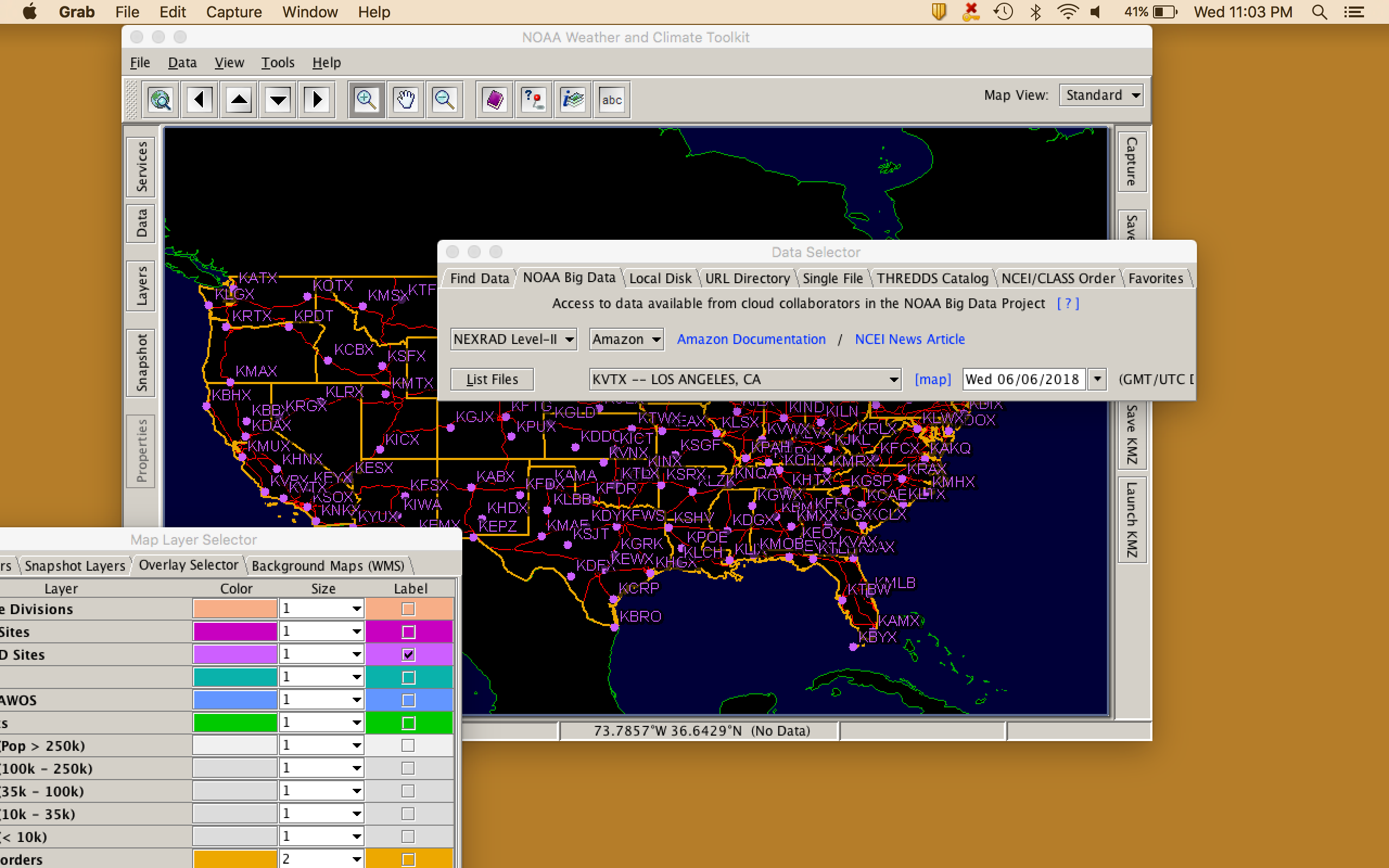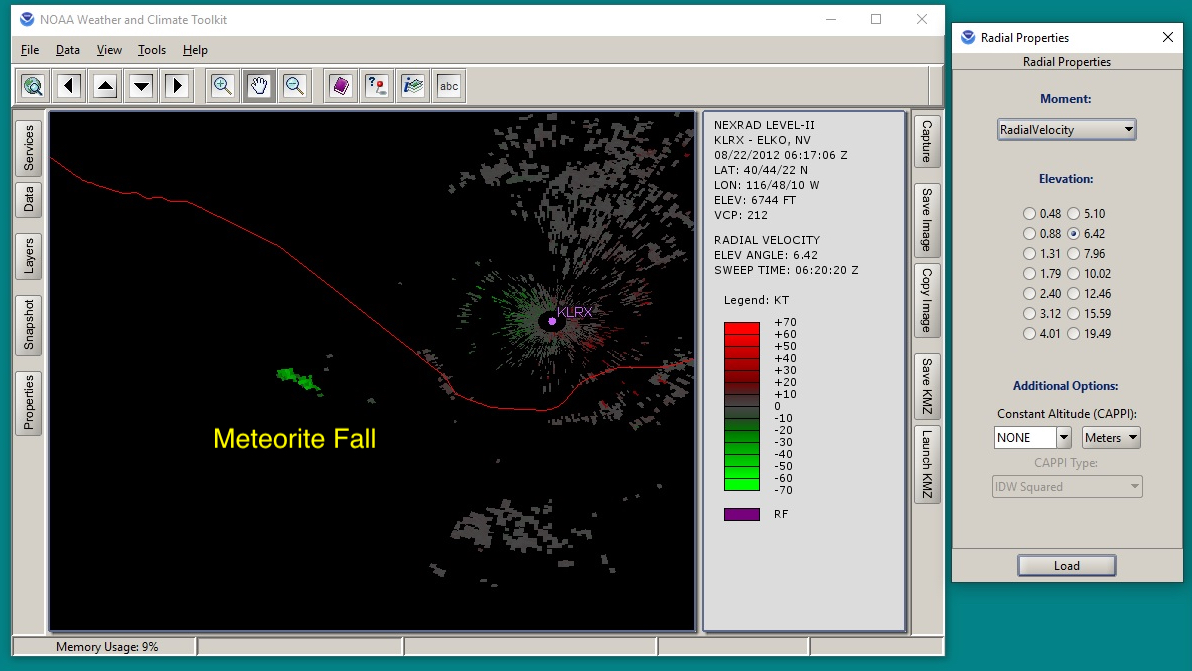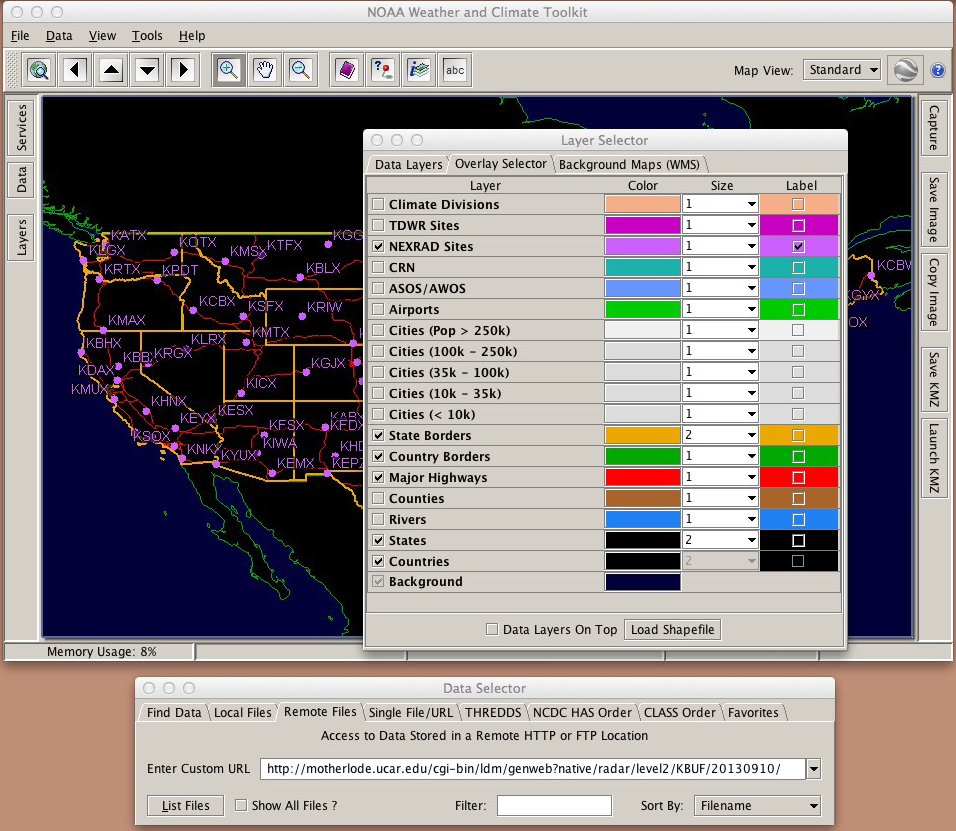HOW TO FIND METEORITES
APPENDIX 1
HOW TO FIND METEORITES
APPENDIX 1
HOW TO FIND METEORITES
APPENDIX 1
| AUTHOR |
Dr. Marc Fries |
LAST UPDATED |
8/1/2023 @ 5:14 PM |
| AUTHOR |
Dr. Marc Fries |
| LAST UPDATED |
8/1/2023 @ 5:14 PM |
Using the NOAA Weather and Climate Toolkit for Recent Meteor Events
STEP ONE
STEP ONE
Download, install and open the Toolkit. This software opens several windows.
STEP TWO
STEP TWO
Move the "Data Selector" bar aside; you'll use it again later. Go to the "Data"
pull-down menu and select "Layer Selector". A new box will open.
STEP THREE
STEP THREE
In the "Map Layer Selector" box, click on the "Overlay Selector" tab. Then check
the two check boxes on either side of "NEXRAD Sites". The box on the left adds
the location of all of the radars of NOAA’s NEXRAD radar network, and the box
on the right shows each radar’s name on the map. All NEXRAD radars have a
four-letter name, most of which start with “K”. Now your map shows the names
and locations of every NEXRAD radar. You'll want to do this every time you
open this software package.
STEP FOUR
STEP FOUR
Now move the "Layer Selector" box out of the way. You're now going to request
the radar data associated with the meteor you're examining by choosing a radar
and the date associated with the meteor. Return to the “Data Selector” window
and choose the “NOAA Big Data” tab. There is a pull-down menu in the bottom-center
of the window. Pull that menu down and select the radar closest to the possible
meteorite fall site.
For this example, we have chosen the KBUF radar. Now adjust the date in the
lower-right pull-down menu to examine radar data collected on 09 Sep 2013.
In place of 20130910 (i.e. September 10th, 2013), enter the date of the meteor
event. This must be the UTC date. One way to get the UTC is from the American
Meteor Society’s web page for a meteor event. Another way is to convert a known
fireball time to UTC using an online time zone converter, such as this one:
http://www.timeanddate.com/worldclock/converter.html
When you have selected a radar and the date, click on "List Files" in the lower
left-hand corner of the "Data Selector" box.

STEP FIVE
STEP FIVE
Once you've selected the radar and date, you should see the next image. Scroll
down to the data set for the time you want to examine. You should examine all
the radar data sets starting with at least one BEFORE the meteor event, from
anywhere to 30 to 60 minutes after the meteor. This is done to familiarize
yourself with noise and radar reflections from static objects such as radio
towers. Meteorite falls come and go over a short period of time – they will
not be present before the meteor event or long afterwards.
STEP SIX
STEP SIX
Each data set contains multiple radar "sweeps". Each radar sweep is a single 360°
rotation of the radar dish, at the elevation (in degrees) above horizontal shown
in the "Radial Properties" box. NEXRAD radars start with a 360° sweep at the
lowest angle, then the radar physically pivots upward to the next higher angle,
then sweeps through 360°. Click through the buttons in the "Radial Properties"
box to see images collected at the different radar sweeps.
To toggle between Reflectivity (i.e. energy reflected from an object or refracted
by turbulence) and Doppler velocity (speed that each pixel with a Reflectivity
value is moving), pull down the menu under the word "Moment:" and select either
"Reflectivity" or "Radial Velocity".
Make sure to examine each potential meteorite signature in both reflectivity and
velocity data. The image above shows the 6.42° sweep in Reflectivity data. It is
from the same data set as the previous image.
Now, changing through the different radar sweeps, look near the time and place
for the meteor event and look for signatures of a meteorite fall. Meteorite falls
are different from the weather and other features seen on radar, because falling
meteorites often leave a turbulent wake behind the falling stones. That wake is
visible as a colored feature in the Velocity data (see image below).
You should also look for a long, skinny feature like that seen here, which is caused
by meteorites falling along their direction of motion. Finally, falling meteorites
do exactly that – they fall. On radar, meteorite falls tend to appear at high altitude
first and then migrate down to lower altitudes over a span of time ranging from a
few minutes to up to 15 minutes long.

METEORITES 101
This step-by-step guide will show you how to locate meteorite fall sites
using radar software and weather data along with info provided by reporting
agencies and monitoring systems.
These instructions will show you how to best preserve the meteorites you
discover and how to make contact with the organizations that are willing
to accept and analyze your find.
Don't know exactly what a meteorite is, what they are made of or where
they come from? If that's the case, we have provided a mini-"crash"
course in what you need to know about them.
It turns out that meteorites have provided us a lot of scientific insight,
not only into the origins of our solar system and planet Earth, but what
the future might hold for mankind.
There's a lot going on in the study of meteorites, both here at NASA
and in other places. Here are a few links to the people and institutions
who are leading the research in this field.





